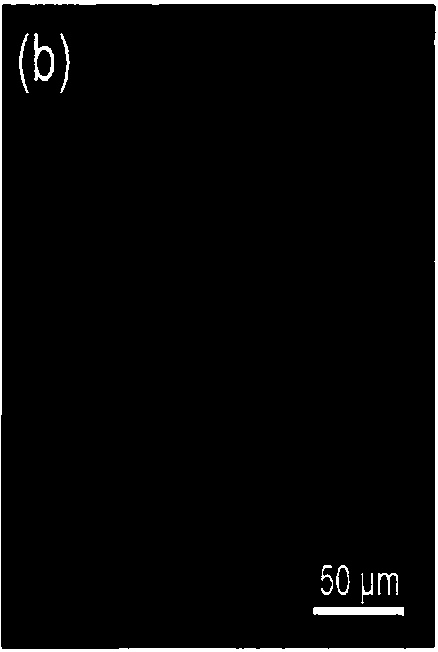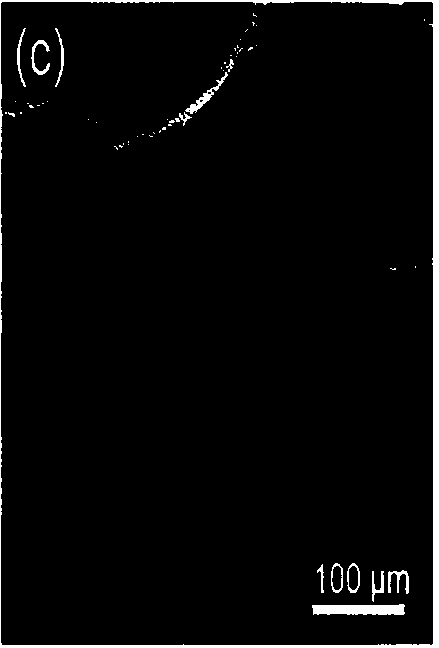Preparation method of novel ultrahigh-sensitive ascorbic acid biological sensing material
A biosensing and ascorbic acid technology, which is applied in the field of biosensing and detection, can solve the problems of non-self-supporting and difficult to change the shape, and achieves the effect of improving the active surface area, preventing agglomeration and high sensitivity.
- Summary
- Abstract
- Description
- Claims
- Application Information
AI Technical Summary
Problems solved by technology
Method used
Image
Examples
Embodiment 1
[0037] Take 4 square centimeters of nickel foam after ultrasonic cleaning with ethanol and deionized water to obtain the template required for three-dimensional graphene. The clean nickel foam is loaded in a quartz boat and sent to a CVD tube furnace to ensure air tightness. Pass 150sccm H into the quartz tube 2 and 300sccm Ar, the pressure inside the tube was brought to atmospheric pressure and the temperature was raised to 1000°C within 1 hour. Pour 15 sccm of methane gas with a purity of more than 99% and keep it for 10 minutes, then turn off the methane gas and rapidly cool to room temperature within 10 minutes to obtain nickel three-dimensional graphene. The obtained sample was placed in a 3 M HCl solution and kept at 80°C for 3 hours to remove the nickel template to obtain a three-dimensional self-supporting graphene framework. The three-dimensional graphene was used as the working electrode, the platinum wire was used as the counter electrode, and the calomel electrode...
Embodiment 2
[0040] Take 100 square centimeters of nickel foam and ultrasonically clean it with ethanol and deionized water to obtain the template required for three-dimensional graphene. The clean nickel foam is loaded in a quartz boat and sent to a CVD tube furnace to ensure air tightness. Pass 1000sccmH into the quartz tube 2 and 3000sccmAr, the pressure inside the tube was brought to atmospheric pressure and the temperature was raised to 1000°C within 1 hour. Pour 100sccm of methane gas with a purity of more than 99% and keep it for 10 minutes, then turn off the methane gas and rapidly cool to room temperature within 10 minutes to obtain nickel three-dimensional graphene. The obtained sample was placed in a 3 M HCl solution and kept at 80°C for 3 hours to remove the nickel template to obtain a three-dimensional self-supporting graphene framework. The three-dimensional graphene was used as the working electrode, the platinum wire was used as the counter electrode, and the calomel elect...
Embodiment 3
[0043] Take 4 square centimeters of nickel foam after ultrasonic cleaning with ethanol and deionized water to obtain the template required for three-dimensional graphene. The clean nickel foam is loaded in a quartz boat and sent to a CVD tube furnace to ensure air tightness. Pass 150sccmH into the quartz tube 2 and 300sccmAr, the pressure inside the tube was brought to atmospheric pressure and the temperature was raised to 1000°C within 1 hour. Pour 15 sccm of methane gas with a purity of more than 99% and keep it for 5 minutes, then turn off the methane gas and rapidly cool to room temperature within 10 minutes to obtain nickel three-dimensional graphene. The obtained sample was placed in a 3 M HCl solution and kept at 80°C for 3 hours to remove the nickel template to obtain a three-dimensional self-supporting graphene framework. The three-dimensional graphene was used as the working electrode, the platinum wire was used as the counter electrode, and the calomel electrode wa...
PUM
 Login to View More
Login to View More Abstract
Description
Claims
Application Information
 Login to View More
Login to View More - R&D
- Intellectual Property
- Life Sciences
- Materials
- Tech Scout
- Unparalleled Data Quality
- Higher Quality Content
- 60% Fewer Hallucinations
Browse by: Latest US Patents, China's latest patents, Technical Efficacy Thesaurus, Application Domain, Technology Topic, Popular Technical Reports.
© 2025 PatSnap. All rights reserved.Legal|Privacy policy|Modern Slavery Act Transparency Statement|Sitemap|About US| Contact US: help@patsnap.com



